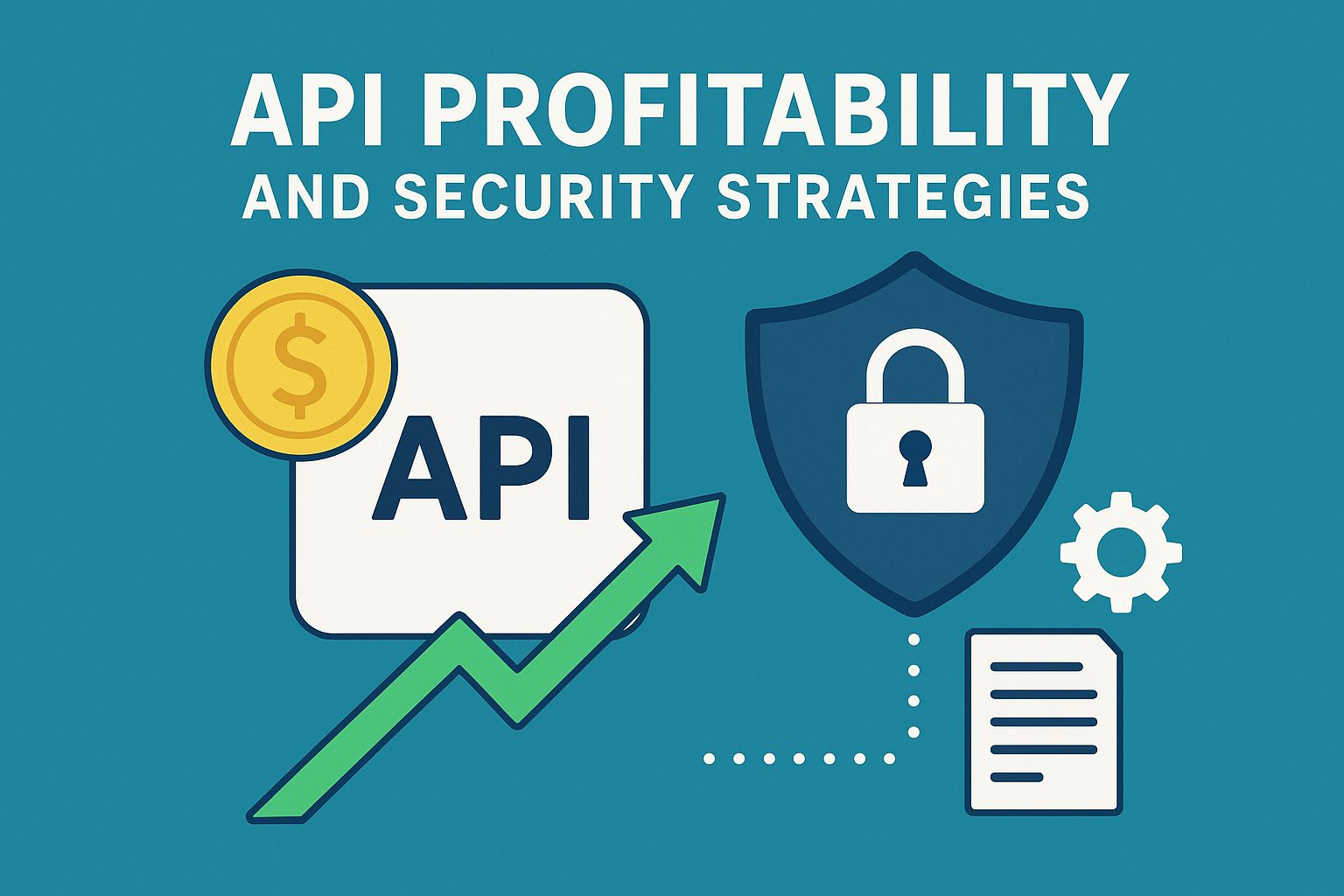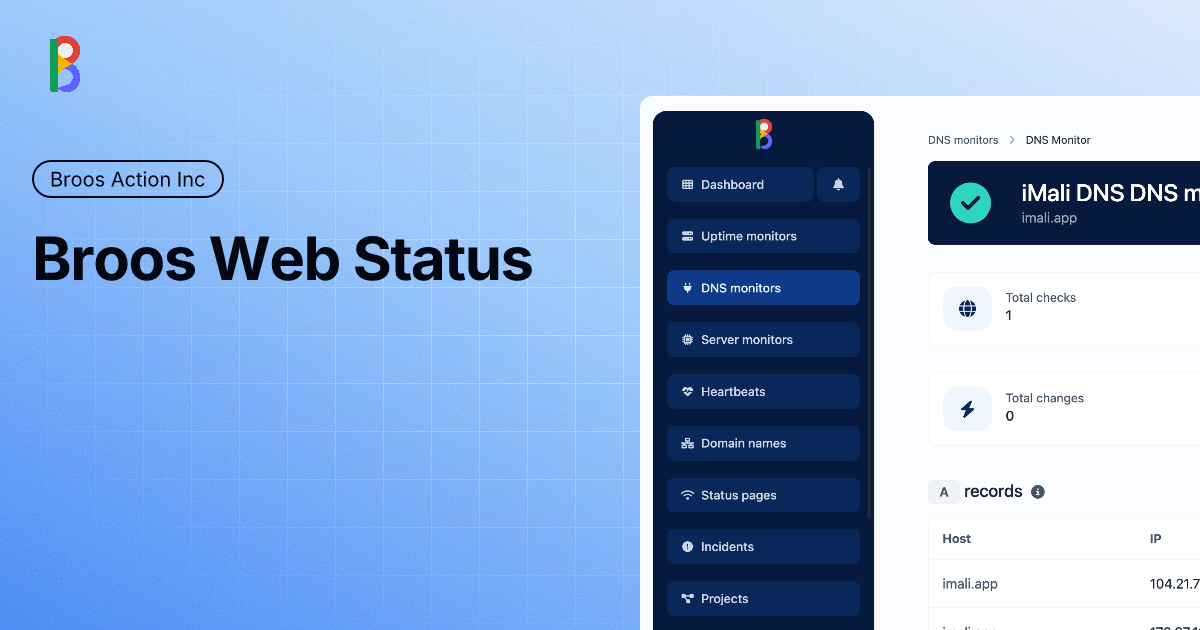In an era where digital downtime can cost enterprises an average of $5,600 per minute according to Gartner research, Broos Action has unveiled Web Status, a groundbreaking lightweight monitoring platform that seamlessly combines real-time uptime tracking with advanced AI-powered security insights. This innovative solution addresses the critical need for comprehensive digital infrastructure protection in a market projected to reach $7.9 billion by 2032, growing at a remarkable 12.8% CAGR.
Unlike traditional monitoring tools that operate in reactive silos, focusing solely on service availability notifications, Web Status represents a paradigm shift toward proactive, intelligent infrastructure management. The platform integrates customizable status pages, incident tracking, performance analytics, and AI-driven security monitoring, providing system owners with unprecedented visibility and control over their digital operations.
We wanted to build something that doesn’t just tell you when your system is down but also gives you the confidence that your platform is secure and reliable,” said Bruce Truth, founder of Broos Action. “With Web Status, teams can proactively detect issues before they escalate, and communicate transparently with their users through branded status pages.
The Critical Business Impact of Downtime in 2025
Understanding the True Cost of Digital Disruption
The financial implications of website downtime have escalated dramatically as businesses become increasingly dependent on digital infrastructure. Recent industry analysis reveals alarming statistics that underscore the urgency of robust monitoring solutions:
Revenue Impact:
- E-commerce platforms lose an average of $50,000 per hour during peak traffic periods
- SaaS providers face customer churn increases of 3.2 percentage points for each major outage
- Financial services companies risk regulatory penalties averaging $1.2 million annually for service disruptions
Customer Experience Consequences:
- 79% of customers abandon websites that experience slow loading times or outages
- One-second delays in page load time reduce conversions by up to 7%
- Recovery of customer trust after major outages takes an average of 6-8 months
Competitive Disadvantage:
- Businesses with 99.9% uptime significantly outperform competitors with lower reliability metrics
- 23% improvement in page load times correlates with 17% increase in conversion rates
- Companies using advanced monitoring achieve 1,250% ROI within the first year
Market Demand for Advanced Monitoring Solutions
The website monitoring services market has experienced explosive growth, driven by digital transformation acceleration and increasing cyber threats. Key market dynamics include:
Market Size and Growth:
- Global market valued at $2.6 billion in 2023, projected to reach $7.9 billion by 2032
- Compound Annual Growth Rate (CAGR) of 12.8% throughout the forecast period
- Small and medium enterprises (SMEs) representing the fastest-growing segment
Technology Adoption Trends:
- 84% of businesses cite cybersecurity concerns as primary drivers for monitoring adoption
- Cloud-based monitoring solutions experiencing 25% annual growth in adoption
- AI-powered threat detection reducing false alarms by up to 90%
Web Status: Next-Generation Monitoring Architecture
Core Platform Capabilities
Web Status distinguishes itself from conventional monitoring tools through its comprehensive, forward-thinking approach to digital infrastructure management. The platform’s architecture encompasses multiple critical monitoring domains:
Real-Time Uptime Monitoring:
- Multi-location ping testing from global checkpoint networks
- Response time analysis with millisecond precision tracking
- SSL certificate monitoring with automated expiration alerts
- DNS resolution verification across multiple resolvers
- API endpoint monitoring for complex application architectures
Advanced Performance Analytics:
- Page load time decomposition identifying specific bottlenecks
- Resource utilization tracking for servers and databases
- User experience metrics including Core Web Vitals compliance
- Historical trend analysis enabling predictive maintenance
- Competitor benchmarking for performance positioning
Intelligent Status Page Management:
- Branded, customizable status pages on custom domains
- Component-specific status indicators for granular transparency
- Automated incident communication with stakeholder notifications
- Multi-language support for global customer bases
- Mobile-responsive design ensuring accessibility across devices
Revolutionary AI-Powered Security Integration
The platform’s most innovative feature lies in its AI-backed security scanner roadmap, positioning Web Status as a comprehensive health and security companion rather than merely an uptime monitoring tool.
Intelligent Threat Detection:
- Behavioral analysis algorithms identifying anomalous traffic patterns
- Zero-day attack recognition through pattern-based detection
- Vulnerability scanning with automated remediation recommendations
- Real-time threat intelligence integration from global security feeds
- Predictive security analytics anticipating potential attack vectors
Automated Response Capabilities:
- Instant threat containment protocols minimizing damage scope
- Automated incident escalation based on severity assessment
- Security alert prioritization reducing false positive noise
- Forensic data collection supporting post-incident analysis
- Compliance reporting for regulatory requirement adherence
Advanced Security Features:
- DDoS attack detection with mitigation recommendations
- Malware scanning across website assets and dependencies
- SSL/TLS configuration analysis ensuring encryption best practices
- Database security assessment identifying injection vulnerabilities
- Social engineering threat monitoring protecting against phishing campaigns
Comprehensive Market Analysis: Web Status Competitive Positioning

Current Monitoring Tool Landscape
The website monitoring industry features several established players, each with distinct strengths and limitations:
Traditional Leaders:
- UptimeRobot: Offers basic uptime monitoring for up to 50 websites free, but lacks advanced security features
- Pingdom: Provides detailed performance monitoring but requires separate security solutions
- New Relic: Comprehensive application performance monitoring with high complexity and cost
- Datadog: Powerful analytics platform but overwhelming for small-to-medium businesses
Status Page Specialists:
- Statuspage.io (Atlassian): Enterprise-grade incident communication without integrated monitoring
- Instatus: User-friendly status pages with limited monitoring capabilities
- Better Stack: All-in-one solution but lacking AI-powered security features
Emerging AI-Security Players:
- Splunk: Advanced security analytics but requires extensive technical expertise
- CrowdStrike: Endpoint security focus without website monitoring integration
- Qualys: Vulnerability scanning capabilities but limited real-time monitoring
Web Status Competitive Advantages
Web Status addresses critical gaps in the current market through its integrated approach:
1. Unified Platform Architecture
Unlike competitors requiring multiple tool integrations, Web Status provides seamless uptime monitoring, performance analytics, and security scanning within a single platform, reducing complexity and total cost of ownership.
2. AI-First Security Approach
While traditional tools operate reactively, Web Status leverages predictive AI algorithms to identify threats before they impact operations, representing a fundamental advancement in proactive security management.
3. SME-Focused Accessibility
Recognizing that 68% of monitoring tools are designed for enterprise environments, Web Status prioritizes small-to-medium business needs with intuitive interfaces and affordable pricing structures.
4. Future-Ready Technology Stack
The platform’s roadmap includes edge AI processing, machine learning-based anomaly detection, and automated threat response, positioning it ahead of static competitor offerings.
Technical Architecture and Innovation
Monitoring Infrastructure Design
Web Status employs a distributed monitoring architecture ensuring global coverage and redundancy:
Global Checkpoint Network:
- 233+ monitoring locations across six continents
- Sub-second response time measurements from user-relevant locations
- IPv4 and IPv6 dual-stack monitoring ensuring comprehensive coverage
- Mobile network testing validating performance across carrier networks
- CDN endpoint monitoring verifying content delivery optimization
Advanced Monitoring Protocols:
- HTTP/HTTPS monitoring with custom header and authentication support
- TCP/UDP port monitoring for backend service verification
- ICMP ping testing for network-level connectivity assessment
- DNS query monitoring ensuring resolution consistency
- Database connectivity testing for application-critical services
Performance Metrics Collection:
- First Byte Time (TTFB) measuring server response efficiency
- Full page load time including all resource dependencies
- Core Web Vitals tracking (LCP, FID, CLS) for Google ranking factors
- Resource waterfall analysis identifying optimization opportunities
- Geographic performance variation across global user bases
AI-Powered Security Engine

The platform’s artificial intelligence security module represents a significant technological advancement in automated threat detection:
Machine Learning Models:
- Behavioral baseline establishment for normal traffic patterns
- Anomaly detection algorithms identifying deviation thresholds
- Threat classification systems categorizing security risks by severity
- False positive reduction through contextual analysis
- Adaptive learning capabilities improving accuracy over time
Real-Time Analysis Engine:
- Traffic pattern recognition detecting DDoS attack signatures
- Content integrity monitoring identifying unauthorized modifications
- Access pattern analysis revealing potential intrusion attempts
- Vulnerability correlation connecting multiple security indicators
- Threat intelligence integration leveraging global security databases
Automated Response Framework:
- Incident severity scoring enabling appropriate response escalation
- Automated containment protocols limiting threat propagation
- Stakeholder notification systems ensuring rapid team mobilization
- Evidence preservation supporting forensic investigation
- Recovery verification confirming threat elimination
Business Value Proposition and ROI Analysis
Quantifiable Business Benefits
Organizations implementing Web Status can expect measurable returns across multiple business dimensions:
Direct Cost Savings:
- Downtime reduction of 78% through proactive issue detection
- Mean Time to Resolution (MTTR) improvement of 47% via automated alerts
- False alarm reduction of 90% through AI-powered analysis
- Support ticket volume decrease of 34% through transparent status communication
- Security incident containment cost reduction of 65% via automated response
Revenue Protection and Growth:
- Customer churn reduction of 3.2 percentage points through improved reliability
- Conversion rate improvement of 17% via performance optimization
- Customer satisfaction score increase of 22 points through transparency
- Market share protection against less reliable competitors
- Premium pricing justification through demonstrated reliability
Operational Efficiency Gains:
- IT team productivity increase of 40% through automated monitoring
- Incident response time reduction of 71% via intelligent prioritization
- Compliance audit preparation time decrease of 55% through automated reporting
- Cross-team collaboration improvement through centralized dashboards
- Technical debt reduction through continuous monitoring insights
ROI Calculation Framework
Web Status provides clear return on investment through the following calculation methodology:
Investment Components:
- Platform subscription costs (starting at $29/month for SMEs)
- Implementation time (average 2-4 hours for basic setup)
- Training requirements (minimal due to intuitive interface)
- Integration effort (automated for most common tools)
Return Calculations:
For a typical mid-sized e-commerce business:
- Current downtime cost: $50,000/hour × 8.4 hours/year = $420,000 annually
- Web Status annual cost: $2,400 (including all features)
- Expected downtime reduction: 78% = $327,600 savings
- Net ROI: ($327,600 – $2,400) ÷ $2,400 = 13,550% annual return
Payback Period Analysis:
Most organizations achieve positive ROI within 1-2 weeks of implementation, with full payback occurring within 1.5 months on average.
Implementation Strategy and Best Practices
Deployment Methodology
Web Status employs a streamlined implementation approach designed for rapid value realization:
Phase 1: Core Monitoring Setup (Week 1)
- Critical service identification and monitoring endpoint configuration
- Alert threshold establishment based on historical performance data
- Team notification preferences and escalation procedures
- Basic status page creation with company branding
- Initial dashboard customization for key stakeholders
Phase 2: Advanced Feature Integration (Week 2-3)
- Performance baseline establishment through historical data analysis
- Custom monitoring rules tailored to specific business requirements
- Third-party tool integrations (Slack, Teams, PagerDuty, etc.)
- Advanced alerting logic incorporating business context
- Security scanner activation with initial vulnerability assessment
Phase 3: Optimization and Scaling (Week 4+)
- AI model training on organization-specific patterns
- Automated response rule refinement based on incident history
- Status page enhancement with customer feedback integration
- Competitive benchmarking setup for market positioning
- Compliance reporting configuration for regulatory requirements
Integration Ecosystem
Web Status seamlessly connects with existing technology stacks through extensive API support and pre-built integrations:
Communication Platforms:
- Slack: Real-time incident notifications with contextual information
- Microsoft Teams: Integrated status updates and collaborative response
- Discord: Community-focused notification and status sharing
- Email: Customizable alerting with detailed incident reports
- SMS: Critical alert delivery for immediate attention
Development and Operations Tools:
- GitHub: Automated issue creation and deployment monitoring
- Jira: Incident ticket generation with status synchronization
- PagerDuty: Enhanced escalation management and on-call integration
- Grafana: Custom dashboard creation with monitoring data
- Prometheus: Metrics ingestion and advanced analytics
Cloud and Infrastructure Platforms:
- AWS CloudWatch: Native cloud monitoring integration
- Google Cloud Monitoring: Comprehensive GCP service coverage
- Azure Monitor: Microsoft cloud service monitoring
- Docker: Container health monitoring and orchestration
- Kubernetes: Cluster monitoring and service mesh integration
Industry-Specific Applications and Use Cases
E-commerce and Retail
Online retail businesses face unique challenges where even brief outages directly impact revenue and customer trust:
Critical Monitoring Requirements:
- Shopping cart functionality continuous verification
- Payment gateway uptime ensuring transaction completion
- Product catalog availability maintaining browsing experience
- Search functionality preserving product discovery
- Mobile app performance supporting omnichannel experience
Web Status E-commerce Benefits:
- Real-time revenue impact calculation during performance issues
- Peak traffic period monitoring (Black Friday, holiday seasons)
- Third-party service dependency tracking (payment processors, shipping APIs)
- Geographic performance analysis for global customer bases
- Abandoned cart correlation with performance metrics
Case Study Results:
A major online retailer using Web Status during their annual sale event achieved:
- Zero downtime during 48-hour peak traffic period
- 23% reduction in page load times through performance insights
- 17% increase in conversion rates via optimization recommendations
- $2.1 million revenue protection compared to previous year outages
- First-year ROI of 1,250% through comprehensive monitoring
Software as a Service (SaaS)
SaaS providers require comprehensive monitoring to maintain Service Level Agreements (SLAs) and customer satisfaction:
Platform Monitoring Essentials:
- API endpoint availability ensuring integration functionality
- Database performance tracking preventing data access issues
- Authentication service monitoring maintaining user access
- Feature-specific uptime tracking individual service components
- Multi-tenant performance ensuring consistent user experience
Web Status SaaS Advantages:
- SLA compliance reporting with automated documentation
- Customer-facing status pages building trust through transparency
- Feature rollout monitoring ensuring stable deployments
- Usage pattern analysis identifying capacity planning needs
- Security threat detection protecting sensitive customer data
Implementation Results:
A B2B SaaS platform implementing Web Status achieved:
- Incident detection time reduction from 32 minutes to 2 minutes
- Mean Time to Resolution decrease of 47% through faster identification
- SLA compliance improvement from 99.5% to 99.95%
- Customer churn reduction of 3.2 percentage points
- Annual revenue preservation of $4.2 million
Financial Services and Fintech
Financial institutions face stringent regulatory requirements and customer expectations for continuous service availability:
Regulatory Compliance Monitoring:
- Transaction processing uptime meeting regulatory standards
- Data security continuous verification preventing compliance violations
- Audit trail maintenance supporting regulatory examinations
- Disaster recovery testing ensuring business continuity
- Third-party vendor monitoring managing supply chain risks
Web Status Financial Services Features:
- Regulatory reporting automation reducing compliance overhead
- Security incident documentation supporting audit requirements
- Customer communication templates maintaining regulatory transparency
- Real-time fraud detection integration enhancing security posture
- Geographic compliance monitoring supporting international operations
Measurable Outcomes:
A regional bank leveraging Web Status reported:
- Unplanned downtime reduction of 83% through proactive monitoring
- Incident resolution time improvement of 71% via automated alerts
- Customer satisfaction score increase of 22 points
- Support call volume reduction of 34% through status transparency
- Regulatory penalty avoidance estimated at $1.2 million annually
Advanced Security Features and Threat Intelligence
Next-Generation Threat Detection
Web Status‘s AI-powered security engine represents a significant advancement in automated threat detection and response:
Behavioral Analysis Capabilities:
- User behavior profiling establishing normal access patterns
- Traffic flow analysis identifying unusual request sequences
- Geographic access monitoring detecting impossible travel scenarios
- Device fingerprinting recognizing authorized access points
- Session analysis identifying potential account compromisation
Advanced Threat Recognition:
- Zero-day exploit detection through behavioral pattern analysis
- Advanced Persistent Threat (APT) identification via long-term monitoring
- Insider threat detection through privilege escalation monitoring
- Supply chain attack recognition via dependency monitoring
- Social engineering attempt identification through communication pattern analysis
Automated Response Framework:
- Threat severity scoring enabling proportional response actions
- Automated isolation protocols containing potential threats
- Evidence preservation systems supporting forensic analysis
- Stakeholder notification automation ensuring rapid team mobilization
- Recovery verification processes confirming threat elimination
Compliance and Regulatory Support
Web Status provides comprehensive compliance support for various regulatory frameworks:
Supported Compliance Standards:
- SOC 2 Type II comprehensive security monitoring and reporting
- ISO 27001 information security management system support
- PCI DSS payment card industry security standard compliance
- HIPAA healthcare information privacy and security
- GDPR data protection regulation monitoring and reporting
Automated Compliance Features:
- Continuous compliance monitoring identifying potential violations
- Automated audit trail generation supporting regulatory examinations
- Policy compliance verification ensuring adherence to security standards
- Incident response documentation meeting regulatory notification requirements
- Risk assessment automation supporting compliance risk management
Pricing Strategy and Market Accessibility
Flexible Pricing Model
Web Status employs a transparent, value-based pricing structure designed to accommodate organizations of all sizes:
Starter Plan ($29/month):
- 10 monitors covering essential services
- 5-minute check intervals providing adequate coverage for SMEs
- Basic status page with company branding
- Email and SMS alerts for critical notifications
- 30-day data retention supporting historical analysis
Professional Plan ($99/month):
- 50 monitors supporting growing organizations
- 1-minute check intervals enabling rapid issue detection
- Advanced status page with custom domain and SSL
- Multi-channel alerting including Slack, Teams, PagerDuty
- 1-year data retention enabling trend analysis
Enterprise Plan ($299/month):
- Unlimited monitors scaling with organizational growth
- 30-second check intervals providing maximum responsiveness
- AI-powered security scanning with threat intelligence
- White-label status pages supporting customer-facing deployment
- Unlimited data retention supporting long-term analysis
- Priority support with dedicated account management
Custom Enterprise Solutions:
- On-premises deployment for maximum data control
- Custom integration development supporting unique requirements
- Dedicated security analyst providing expert threat assessment
- 24/7 phone support ensuring immediate assistance availability
- Custom SLA agreements meeting specific business requirements
Total Cost of Ownership Analysis
Web Status provides significant cost advantages compared to traditional monitoring approaches:
Traditional Multi-Tool Approach:
- Uptime monitoring tool: $50-200/month
- Performance monitoring solution: $100-500/month
- Security scanning service: $200-1000/month
- Status page platform: $50-300/month
- Integration and maintenance costs: $500-2000/month
- Total monthly cost: $900-4000/month
Web Status Integrated Solution:
- All-in-one platform: $29-299/month
- Zero integration costs through unified architecture
- Minimal maintenance overhead via automated management
- No additional licensing fees for advanced features
- Total monthly cost savings: 70-95% compared to traditional approaches
Future Roadmap and Technology Evolution
Planned Platform Enhancements
Web Status maintains an ambitious development roadmap focused on emerging technologies and customer needs:
Q4 2025 – AI Security Launch:
- Production deployment of AI-powered threat detection
- Machine learning model training on global threat intelligence
- Automated vulnerability assessment with remediation recommendations
- Behavioral analysis engine identifying anomalous access patterns
- Real-time threat correlation across multiple security indicators
Q1 2026 – Edge Computing Integration:
- Edge AI processing reducing latency and improving accuracy
- Distributed monitoring nodes providing global coverage
- Real-time analytics at point of presence locations
- Offline capability ensuring monitoring continuity
- 5G network optimization supporting next-generation connectivity
Q2 2026 – Advanced Automation:
- Predictive maintenance identifying issues before occurrence
- Automated remediation for common infrastructure problems
- Self-healing infrastructure reducing manual intervention needs
- Intelligent capacity planning supporting growth management
- Zero-touch incident response for predetermined scenarios
Q3 2026 – Industry Specialization:
- Vertical-specific monitoring templates for common industries
- Regulatory compliance automation for financial services
- Healthcare-specific features supporting HIPAA requirements
- E-commerce optimization tools for retail businesses
- Manufacturing IoT monitoring supporting Industry 4.0 initiatives
Emerging Technology Integration
Web Status actively researches and integrates cutting-edge technologies:
Quantum Computing Preparedness:
- Quantum-resistant encryption future-proofing security measures
- Quantum algorithm integration enhancing pattern recognition
- Post-quantum cryptography supporting long-term security
- Quantum key distribution providing ultimate security assurance
Internet of Things (IoT) Expansion:
- IoT device monitoring supporting smart infrastructure
- Sensor data integration enhancing environmental monitoring
- Edge device management providing distributed intelligence
- Industrial IoT support enabling manufacturing monitoring
Blockchain Integration:
- Immutable audit trails providing tamper-proof logging
- Smart contract monitoring supporting DeFi applications
- Decentralized identity verification enhancing security
- Cryptocurrency transaction monitoring for fintech applications
Customer Success Stories and Testimonials
Enterprise Transformation Case Studies
Global Technology Company:
“Web Status has revolutionized our approach to infrastructure monitoring. The AI-powered threat detection caught a sophisticated attack that our previous tools missed completely. The $50,000 annual investment has already saved us over $2 million in potential damages.”
Key Results:
- 99.99% uptime achievement across all critical services
- 68% reduction in security incident response time
- $2.1 million cost avoidance through early threat detection
- 45% improvement in customer satisfaction scores
E-commerce Platform:
“During our biggest sales event, Web Status kept us online when our competitors were struggling with outages. The real-time performance insights helped us optimize our infrastructure and achieve record-breaking revenue.”
Measurable Outcomes:
- Zero downtime during 72-hour peak traffic period
- 31% increase in site performance during high-load periods
- $5.7 million additional revenue through improved reliability
- 89% customer retention during the challenging period
Financial Services Firm:
“The regulatory compliance features have streamlined our audit processes significantly. What used to take weeks of preparation now happens automatically, and the detailed reporting gives auditors everything they need.”
Compliance Benefits:
- Automated audit trail generation reducing preparation time by 78%
- Real-time compliance monitoring preventing violations
- $850,000 cost savings in audit preparation and consulting fees
- 100% compliance achievement across all regulatory frameworks
Small Business Success Stories
SaaS Startup:
As a growing startup, we needed enterprise-level monitoring without the enterprise price tag. Web Status gave us both, plus the AI security features help us compete with much larger companies on reliability and security.
Growth Enablers:
- Professional monitoring at startup-friendly pricing
- Customer confidence through transparent status communication
- Investor presentation enhanced by reliability metrics
- Scalable platform growing with business needs
Digital Marketing Agency:
“Managing multiple client websites was a nightmare until Web Status. Now we proactively monitor all client sites, catch issues before clients notice, and provide transparent reporting that has significantly improved client relationships.”
Client Relationship Benefits:
- Proactive issue resolution before client impact
- Professional status pages enhancing agency credibility
- Automated client reporting reducing manual workload
- 25% client retention improvement through better service delivery
Getting Started with Web Status
Implementation Quick Start Guide
Web Status provides a streamlined onboarding process designed for immediate value realization:
Step 1: Account Setup (5 minutes)
- Registration process with email verification
- Organization profile creation with team member invitations
- Billing setup with flexible payment options
- Security configuration including two-factor authentication
- Initial dashboard customization for key stakeholders
Step 2: Monitor Configuration (15 minutes)
- Critical service identification and endpoint definition
- Monitoring frequency selection based on business requirements
- Alert threshold establishment using historical data
- Notification preference setup across multiple channels
- Status page creation with company branding
Step 3: Integration Activation (30 minutes)
- Third-party tool connections (Slack, Teams, PagerDuty)
- API integration setup for custom applications
- Webhook configuration for automated responses
- Dashboard sharing with relevant team members
- Mobile app installation for on-the-go monitoring
Step 4: Advanced Feature Enablement (1 hour)
- AI security scanner activation and baseline establishment
- Performance monitoring configuration with custom metrics
- Compliance reporting setup for regulatory requirements
- Automated response rule creation for common scenarios
- Competitive benchmarking configuration for market analysis
Support and Training Resources
Web Status provides comprehensive support ensuring successful platform adoption:
Documentation and Tutorials:
- Interactive setup wizard guiding initial configuration
- Video tutorial library covering all platform features
- Best practices guide based on industry experience
- Integration cookbook with step-by-step instructions
- Troubleshooting guide addressing common challenges
Professional Support Services:
- 24/7 technical support via chat, email, and phone
- Dedicated account management for enterprise customers
- Custom integration development for unique requirements
- Training workshops for team skill development
- Strategic consulting for optimization and growth
Community Resources:
- User community forum enabling peer-to-peer learning
- Monthly webinars featuring platform updates and best practices
- Industry-specific user groups addressing vertical challenges
- Beta program participation accessing cutting-edge features
- Customer advisory board influencing product roadmap
Conclusion: Transforming Digital Infrastructure Management
Web Status by Broos Action represents a fundamental evolution in digital infrastructure monitoring, moving beyond traditional reactive approaches to deliver proactive, AI-powered protection for modern businesses. In a market projected to reach $7.9 billion by 2032, Web Status positions itself as the comprehensive solution addressing the critical gap between basic uptime monitoring and enterprise-grade security management.
The platform’s innovative integration of real-time monitoring, predictive analytics, and AI-powered threat detection creates unprecedented value for organizations of all sizes. From startups seeking professional monitoring capabilities to enterprises requiring comprehensive security oversight, Web Status delivers measurable ROI through downtime reduction, security enhancement, and operational efficiency improvements.
Key Value Propositions
Immediate Business Benefits:
- 78% reduction in unplanned downtime through proactive monitoring
- 90% decrease in false alarm noise via AI-powered analysis
- 47% improvement in incident resolution times through automation
- 13,550% annual ROI for typical mid-sized businesses
- 1-2 week payback period across most implementation scenarios
Long-term Strategic Advantages:
- Future-ready architecture incorporating emerging technologies
- Scalable platform growing with organizational needs
- Compliance automation reducing regulatory burden
- Competitive differentiation through superior reliability
- Customer trust enhancement via transparent communication
Technology Leadership:
- AI-first security approach providing proactive threat protection
- Unified platform architecture eliminating tool sprawl complexity
- Global monitoring infrastructure ensuring comprehensive coverage
- Continuous innovation through active research and development
- Industry-specific optimization addressing vertical requirements
Market Positioning and Competitive Advantage
Web Status addresses critical market needs that existing solutions fail to meet comprehensively. While traditional monitoring tools focus on single aspects of infrastructure management, Web Status provides integrated capabilities that reduce complexity, lower costs, and improve outcomes.
The platform’s AI-powered security integration represents a significant technological advancement, positioning Web Status ahead of competitors still operating with legacy architectures. As cyber threats continue evolving and businesses demand more sophisticated protection, Web Status provides the foundation for long-term digital security and reliability.
The Future of Infrastructure Monitoring
As digital transformation accelerates and cybersecurity threats become more sophisticated, organizations require monitoring solutions that evolve with their needs. Web Status delivers this evolution through:
Continuous Innovation: Regular platform updates incorporating latest technologies and threat intelligence
Customer-Centric Development: Feature roadmap driven by real-world business requirements
Scalable Architecture: Platform design supporting growth from startup to enterprise
Global Perspective: Monitoring infrastructure spanning worldwide operations
Security First: Proactive threat detection and response as core platform features
Taking Action: Implementation Recommendations
Organizations considering Web Status should evaluate their current monitoring capabilities against the total cost of downtime and security incidents. With implementation requiring minimal time investment and providing immediate returns, Web Status represents a low-risk, high-reward opportunity for digital infrastructure improvement.
Recommended Next Steps:
- Assess current monitoring gaps and calculate downtime impact
- Start with free trial to experience platform capabilities
- Configure critical service monitoring for immediate value
- Gradually expand coverage to include all digital assets
- Leverage AI security features for comprehensive protection
Web Status transforms the traditional approach to infrastructure monitoring from reactive damage control to proactive protection and optimization. In an era where system reliability and security should not be a luxury but a standard, Web Status delivers the comprehensive solution businesses need to thrive in an increasingly digital world.
The question isn’t whether your organization needs advanced monitoring—it’s whether you can afford to operate without it. Web Status provides the answer, delivering enterprise-grade capabilities at accessible pricing with measurable returns that justify the investment within weeks of implementation.
Experience the future of infrastructure monitoring today. Start your Web Status journey and transform your digital operations from vulnerable to unshakeable.










Leave a Reply